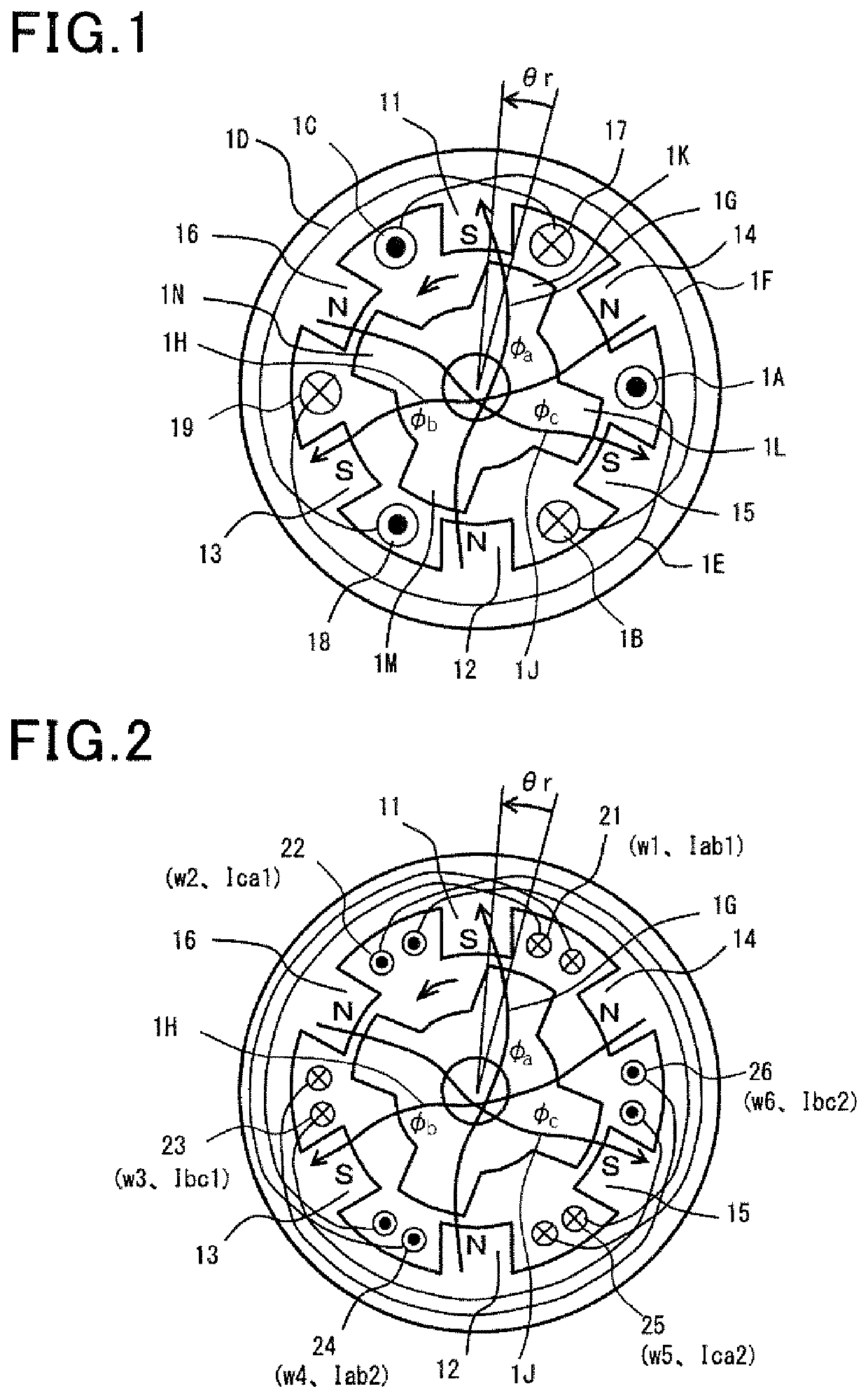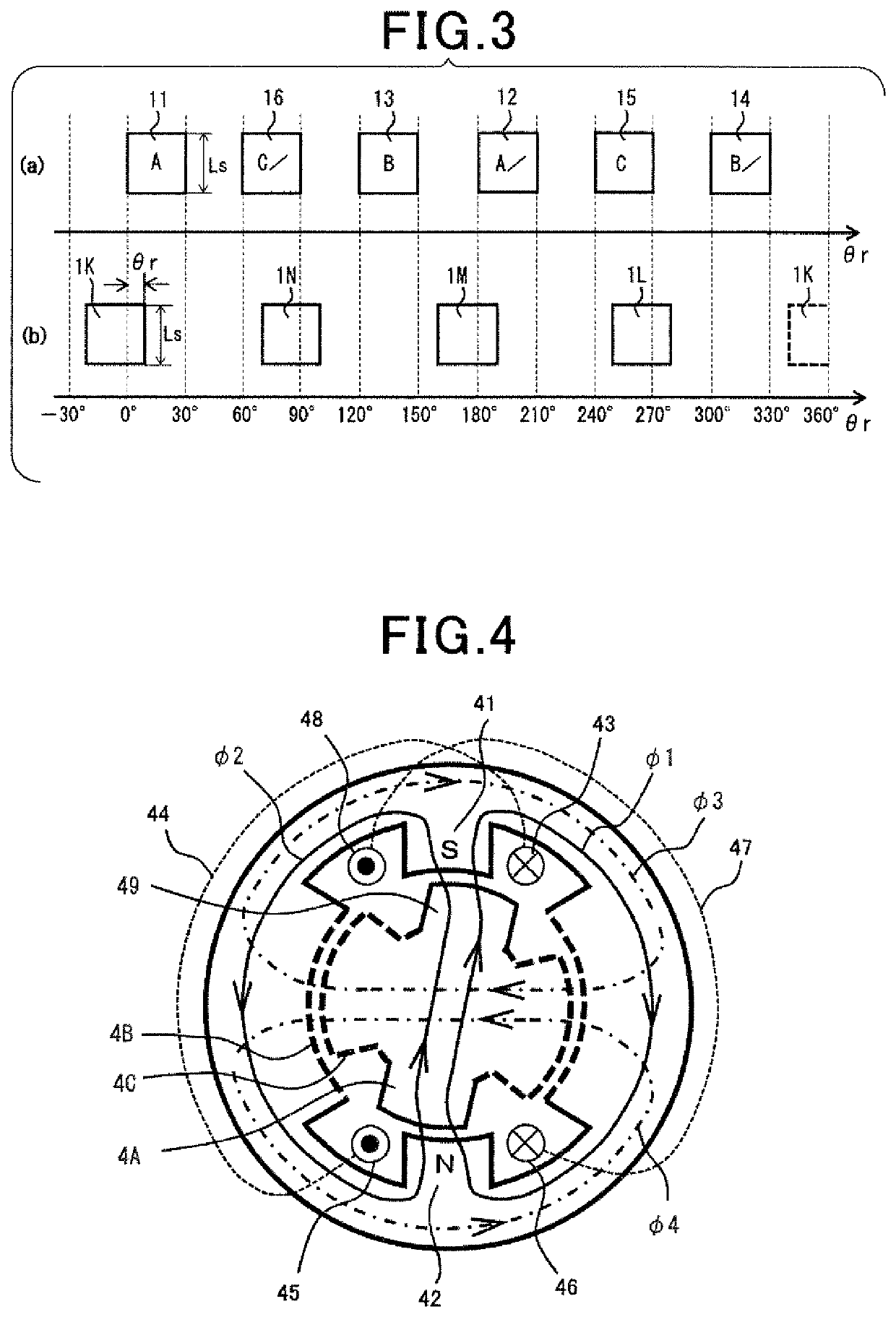Motor and control device therefor
a control device and motor technology, applied in the direction of synchronous motors, magnetic circuit shapes/forms/construction, synchronous motors, etc., can solve the problems of increasing the size of the motor, reducing the service life of the motor, so as to achieve easy application of current, high torque, and simplified over-voltage characteristics.
- Summary
- Abstract
- Description
- Claims
- Application Information
AI Technical Summary
Benefits of technology
Problems solved by technology
Method used
Image
Examples
tenth embodiment
[0505]Next, another embodiment according to claim 1 is shown in the cross-sectional view of FIG. 19 and the drive circuit of FIG. 20. FIG. 19 illustrates a reluctance motor having eight stator magnetic poles and six rotor magnetic poles. FIG. 19(a) shows a conventional reluctance motor, which uses a centralized winding. FIG. 19(b) exemplifies a reluctance motor in which full pitch winding windings in parallel are wound in each slot. The reason for arranging the windings in parallel is the same as in the case of the configuration shown in FIG. 2. This motor is driven using the circuit shown in FIG. 20. The windings on both sides of each stator pole are connected in series and a current is applied. Therefore, when each stator magnetic pole is excited, the interlinkage magnetic fluxes of the other phases are canceled out and are not affected by the interlinkage magnetic flux.
[0506]In FIG. 19(a), reference numeral 901 is an A5 phase stator magnetic pole, and reference numeral 902 is an ...
eleventh embodiment
[0563]Next, another embodiment of the drive circuit according to claim 1 will be described with reference to FIG. 21. In the case of the drive circuit of FIG. 20, a configuration is adopted in which two sets of currents of each phase can be energized, the symmetry of the circuit is maintained, and each transistor can be driven efficiently. The total current capacity of the transistor is small. However, since two sets of currents in each phase are energized, there is a disadvantage that the number of transistors increases to 10. Therefore, FIG. 21 shows an example of another drive circuit. This drive circuit adopts a configuration in which one transistor is added to compensate for the asymmetry of the circuit, and one set of full pitch windings of each phase shown in FIG. 19(b) is completed. That is, the number of full pitch winding windings shown in FIG. 19(b) is four. The number of transistors is “(10) / 2+(1)”=6.
[0564]In the drive circuit configuration shown in FIG. 21, the right ha...
thirteenth embodiment
[0585]Next, another embodiment of claim 1 is shown in the cross-sectional view of FIG. 25 and the drive circuit of FIG. 26.
[0586]In the motor configuration according to this embodiment, the number of stator magnetic poles is 10, and the number of rotor magnetic poles is 6. The circumferential width of each magnetic pole is about 18°. In a specific example described later according to this embodiment, the magnetic pole width is exemplified by 24°. In FIG. 25(a), the winding of the motor acts as a centralized winding. In FIG. 25(b), the winding of the motor is a full pitch winding. For efficient drive, the full pitch winding wound between the two slots is separated into two parallel full pitch windings.
[0587]As described above, in the combination of the motor shown in FIG. 2 and the drive circuit shown in FIG. 6, six stator magnetic poles are illustrated. When the number of stator magnetic poles is 6, 10, 14, 18, 22, or the like, the drive circuit shown in FIG. 6 may be increased by t...
PUM
 Login to View More
Login to View More Abstract
Description
Claims
Application Information
 Login to View More
Login to View More - R&D
- Intellectual Property
- Life Sciences
- Materials
- Tech Scout
- Unparalleled Data Quality
- Higher Quality Content
- 60% Fewer Hallucinations
Browse by: Latest US Patents, China's latest patents, Technical Efficacy Thesaurus, Application Domain, Technology Topic, Popular Technical Reports.
© 2025 PatSnap. All rights reserved.Legal|Privacy policy|Modern Slavery Act Transparency Statement|Sitemap|About US| Contact US: help@patsnap.com



